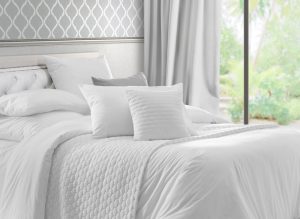Are you finding it challenging to create an ideal workspace within the confines of your bedroom? Setting up a home office in your bedroom demands thoughtful consideration to blend functionality with comfort seamlessly. With the right approach, you can create a productive workspace that enhances your efficiency while maintaining the tranquillity of your personal sanctuary.
Daniel Ufland, the co-founder of Flitch, shares his top seven strategies for maximising productivity in remote work settings.
1. Space Allocation And Layout
Assess your bedroom layout and identify areas where you can carve out space for your home office. Utilise vertical space with shelves or wall-mounted storage to minimise clutter on the floor. Invest in ergonomic furniture like a desk with built-in storage to maximise efficiency.
Daniel says, ‘Consider the direction your desk faces to minimise glare on your computer screen and maximise natural light. Experiment with different layouts to find one that optimises workflow and allows easy access to essential items and equipment.’
2. Boundary Establishment
Daniel emphasises the importance of setting boundaries to create a distinct separation between workspace and relaxation space. ‘Establishing clear boundaries is essential for maintaining a healthy work-life balance,’ he advises. ‘By designating specific work hours and physically separating your workspace from your sleeping area with room dividers or curtains, you promote balance and prevent work from encroaching on your personal time.’
3. Lighting And Noise Management
Choose a location within your bedroom that minimises distractions and maximises natural light. Position your desk near a window to benefit from natural daylight, which can boost mood and productivity.
‘Additionally, minimise distractions and maintain focus by implementing soundproofing techniques or using noise-cancelling headphones,’ notes Daniel. Consider using soft furnishings like rugs, curtains, or acoustic panels to absorb ambient noise and create a quieter work environment within your bedroom.

4. Ergonomic Setup
Invest in ergonomic furniture such as an adjustable chair and desk to support good posture and prevent discomfort or injury. Ensure that your monitor is at eye level and that your keyboard and mouse are positioned to allow for neutral wrist alignment. Additionally, taking regular breaks to stretch and move around helps combat the sedentary nature of desk work, promoting circulation and reducing the risk of musculoskeletal issues associated with prolonged sitting.
5. Privacy Considerations
If privacy is a concern, consider implementing solutions such as frosted glass panels or room dividers to create a sense of separation between your workspace and the rest of your bedroom. Daniel recommends communicating with household members about your need for privacy during work hours to minimise interruptions.
6. Decor And Personalization
Create a conducive work environment by personalising your home office with decor that inspires creativity and motivation. ‘Choose calming colours and decor elements that complement your bedroom’s aesthetic while fostering a productive atmosphere,’ states Daniel. Incorporate plants, artwork, or motivational quotes to enhance the ambience and boost morale.
7. Storage Solutions
Optimise storage space to keep your workspace organised and clutter-free. Invest in multifunctional furniture like a desk with built-in drawers or shelves to store office supplies, paperwork, and electronic devices. Utilise vertical storage options such as wall-mounted shelves or floating cabinets to maximise floor space.
These seven considerations provide a comprehensive roadmap for individuals planning to set up a home office in their bedroom. Daniel says, ‘By focusing on optimising space, maintaining work-life balance, and enhancing productivity, individuals can transform their remote work experience into a platform for unparalleled productivity and innovation.’






